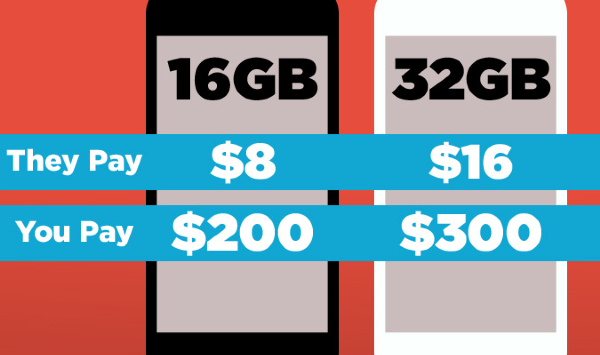Why 16GB Smartphones Are the Biggest Rip-Off in Tech
It costs smartphone makers just 50 cents per gigabyte for smartphone storage, so why are we paying 12 times more? And why so scant to begin?

The other day, I hit a huge wall with my iPhone — a wall so big I couldn't upgrade to the latest version of iOS. My device told me I needed 1.4GB of room when I had only 492MB worth of storage space left. So I had to delete a bunch of apps (some of which I liked) to free up room. True, I cheaped out and bought the lowest-capacity 16GB iPhone 5s last September, but at the time, I didn't want to spend an extra $100 for the 32GB model.
Want to know how much smartphone makers pay for that 16GB worth of extra capacity? Just $8, according to Michael Yang, a senior principal analyst for market research firm IHS. That's the biggest rip-off in tech.
Before you accuse me of picking on the iPhone, note that the 16GB Samsung Galaxy S5 comes with only 10.7GB of usable storage out of the box, compared to 12.9GB for the iPhone 5s. You'll also probably want to remove at least some carrier bloatware from the S5, which the iPhone lacks. However, the Galaxy lets you expand its memory via its microSD card slot; a 32GB card costs just $20.

But back to the maddening rip-off. Yang said smartphone manufacturers pay a measly 50 cents per gigabyte for smartphone storage. So, increasing the standard storage from 16GB to 32GB would cost just $16 per phone. Some flagship phones have already gone this route, but why not all of them?
"Smartphone manufacturers continue to do this because they make a lot of money," Yang told me. "From our teardowns, we can tell you that the profit margin is much higher on a 32GB smartphone versus 16GB."
No kidding. How could Apple, Samsung and the wireless carriers feel right about charging $100 for $8 worth of storage? (Apple and Samsung did not comment for this story when reached.)
Part of the reason why 16GB is no longer a realistic baseline amount is that we use smartphones for a lot more things now. We take photos with higher-resolution cameras, capture full-HD video and download apps that eat up a whole gigabyte or more. For instance, the Sonic Transformed game I had to delete to upgrade my iPhone OS takes up 1.1GB.
A quick survey of the top 15 free apps in the Google Play and Apple App stores revealed that the Google Play marketplace averages 31.6MB per app. Apple's average is about twice as high, at 65 MB per app.
"From the consumer perspective, we see the need to go up in storage capacity as camera megapixels go up, and we create more content and put our entire media libraries on our phones," Yang noted.

As one carrier executive I spoke to (who requested to remain anonymous) pointed out, the rise of higher-speed 4G LTE networks and the power of the cloud somewhat mitigates the need for additional storage. In other words, you don't need extra gigabytes to stream Pandora, Spotify or Netflix. "The speed of the network makes a really big difference," the exec told me. "It's just as easy to stream content as it is to store it on your phone."
Just keep in mind that streaming counts against your data plan if you're not using a Wi-Fi network. (T-Mobile is the lone exception, but only music streaming is free.)
Apple will be taking a step forward with iOS 8 by offering 20GB of storage for a very affordable 99 cents per month. Today, 10GB costs $20 monthly. 5GB will remain free.
Still, while the cloud ostensibly makes extra onboard storage unnecessary, the fact remains that smartphones are transitioning from content-consumption devices to content-creation devices, and the industry isn’t keeping up with that reality. How's this for stagnation: The iPhone has shipped with 16GB standard since the 3GS — in 2009.
The good news is that some companies are getting the message. The HTC One M8, LG G3 and Amazon Fire phone are just three flagships that sport 32GB of storage standard. The LG also features a microSD card slot, letting you add up to an additional 128GB of storage ($114). Amazon, for its part, lets you store an unlimited number of photos in the cloud, too.
"That baseline density is going to go up," Yang predicted. "We expect the next wave of smartphones to see at least one step up, and shoppers are going to look for 32GB or skip to 64GB." The same wireless executive I spoke to agrees that the baseline storage will increase for premium smartphones.
Nevertheless, assuming smartphone makers continue to charge $100 to go from one tier to the next, you'll be paying a $84 premium to jump from 32GB to 64GB. I guess that's better than today's $92 gouging fee to increase from 16GB to 32GB.
Follow Mark Spoonauer at @mspoonauer. Follow Tom's Guide at @tomsguide, on Facebook and on Google+.
Sign up to get the BEST of Tom's Guide direct to your inbox.
Get instant access to breaking news, the hottest reviews, great deals and helpful tips.
Mark Spoonauer is the global editor in chief of Tom's Guide and has covered technology for over 20 years. In addition to overseeing the direction of Tom's Guide, Mark specializes in covering all things mobile, having reviewed dozens of smartphones and other gadgets. He has spoken at key industry events and appears regularly on TV to discuss the latest trends, including Cheddar, Fox Business and other outlets. Mark was previously editor in chief of Laptop Mag, and his work has appeared in Wired, Popular Science and Inc. Follow him on Twitter at @mspoonauer.

